

Some of the best parts of camping happen after dark. Cooking up a campfire culinary masterpiece or finally getting some quiet reading time can make a day of hiking worth the effort. If you forget your flashlight or find out too late that the batteries are dead, a fun camping trip can turn rustic in a hurry. That’s why we don’t just grab a light out of the junk drawer and call it a day; we pack the best camping flashlight we can get our hands on.
Videos by Outdoors
These are some of the best flashlights out there. We have hands-on testing experience with most of them, and we can vouch for their camping credentials. While there are lots of other great products out there, these are tough to beat.
If you’re looking for a good flashlight to become a staple in your camping gear, the Streamlight ProTac is a gear tester’s dream.
This post contains affiliate links. Outdoors.com may earn a commission when you make a purchase through these links. Thank you for your support.
Our Picks for the Best Camping Flashlights
- Best Headlamp – BioLite HeadLamp 425
- Best for Backcountry Camping – Black Diamond Deploy 325 Headlamp
- Best Overall – Streamlight ProTac 1L-1AA
- Best for the Tent – Black Diamond Moji R+ Lantern
- Best Pocket Sized – Fenix E03R v. 2.0 Keychain Flashlight
- Most Durable – Streamlight Sidewinder Compact II
BioLite HeadLamp 425
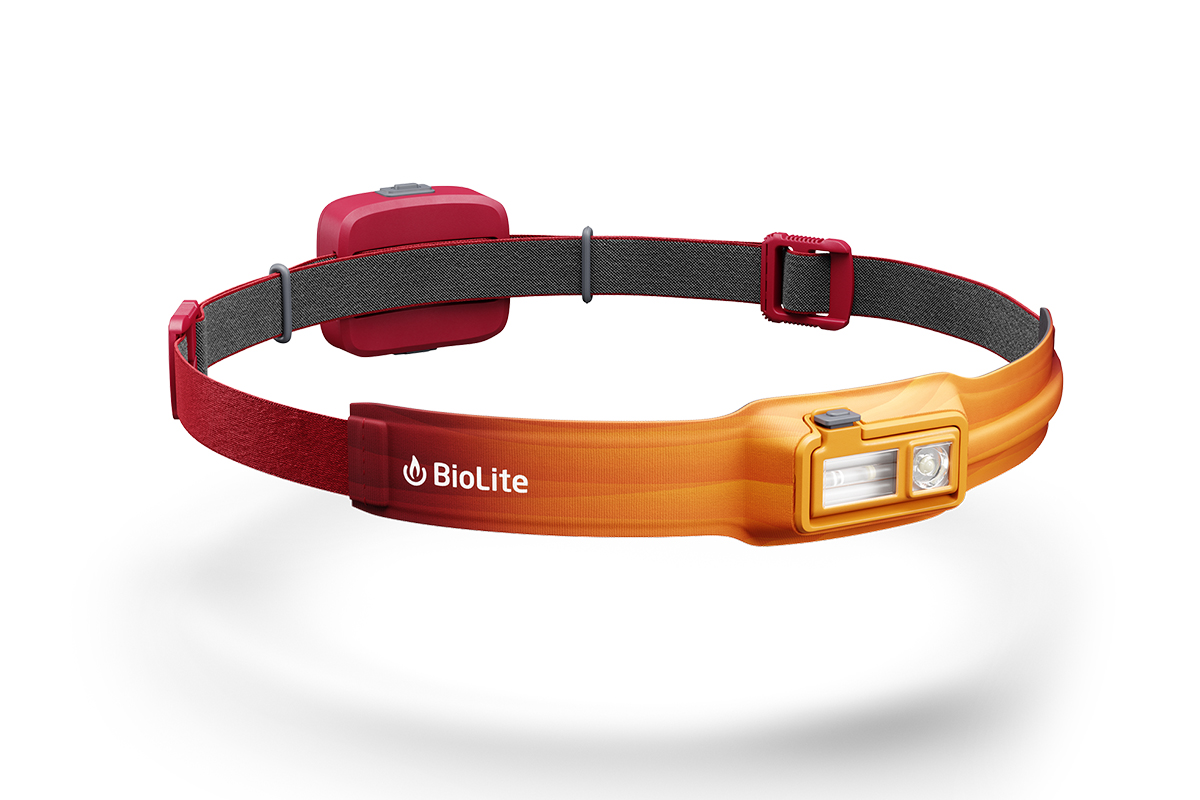
If you have to pick one camping flashlight to do everything, you can’t go wrong with the BioLite HeadLamp 425. This versatile camping light is packed with all the features you need, whether you’re kicking back in your tent or logging a few miles before or after sunset.
Power output is continuously adjustable from 5 to 425 lumens. Modes include a white spotlight, a white floodlight, both of those together, a red floodlight, or a white strobe mode.
The rear-mounted battery pack can provide a red floodlight or a red strobe to keep you visible to others. Battery life is four hours on high or 60 hours on low, and the pack is rechargeable with a USB-C cable.
Moving the battery pack to the rear of the headband makes a big difference in how comfortable it is to wear. If you’re going to be night hiking or running in the dark, it’s a great flashlight to have.
Extra convenience features like the battery life indicator make sure you’re never left in the dark, and a water resistance rating of IPX4 is adequate for most situations.
Why we love it: The rear-mounted battery keeps this feature-rich headlamp balanced and comfortable for hours.
Things we’d change: A more waterproof version would be just about perfect.
Best for Backcountry Camping – Black Diamond Deploy 325 Headlamp
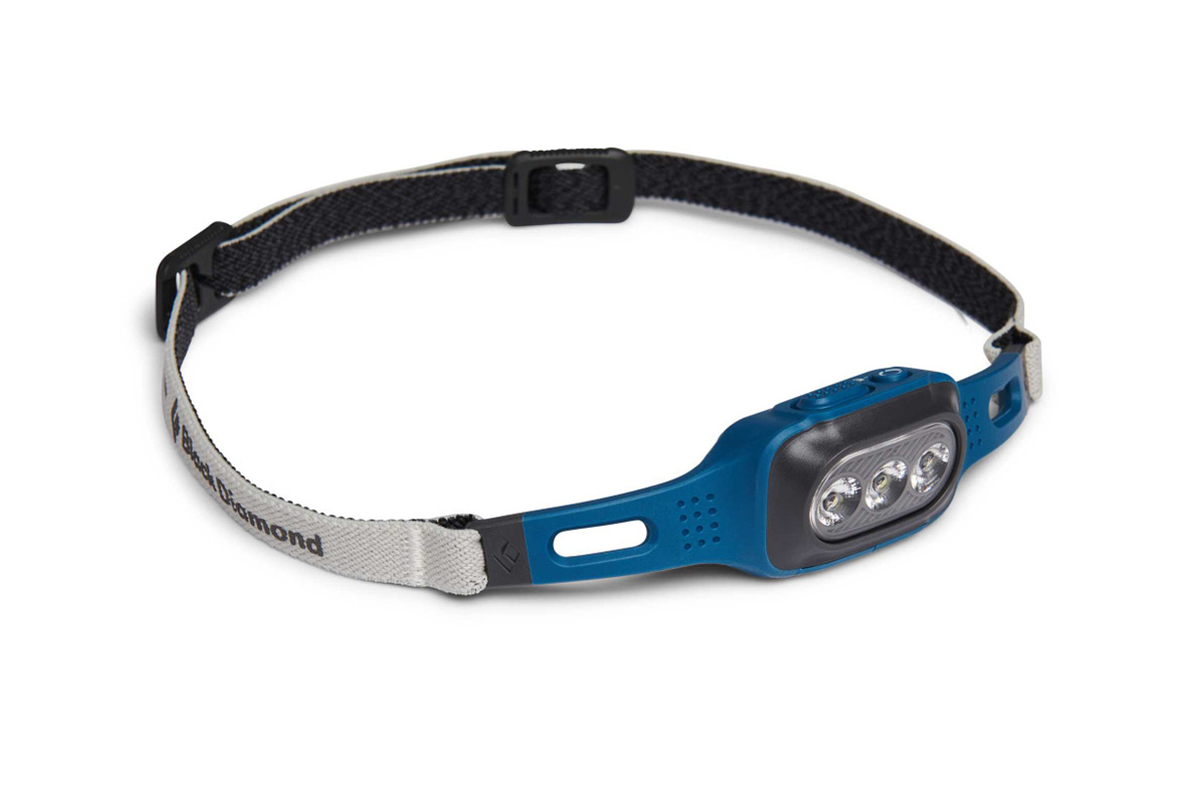
As any ultralight backpacker will tell you, sometimes less is more. That’s certainly true in the case of the Black Diamond Deploy 325 Headlamp, which delivers the light you need with not a single unnecessary ounce to spare.
With a weight of just 1.4 ounces, you probably won’t even feel the Deploy 325 on your forehead. The slim profile of this tiny flashlight even fits underneath a baseball cap so you can avoid a giant shadow from the brim.
Brightness is adjustable on a spectrum up to 325 lumens, so this isn’t a high-powered flashlight by any means, but it’s certainly adequate around the campsite. Depending on the brightness setting, you can expect anywhere from 2.5 to 30 hours from the rechargeable battery.
This is a no-frills option, so you’ll have to forego features like red lights and strobes. What you won’t sacrifice is quality; Black Diamond is known for building some of the best backcountry gear in the business and the Deploy 325 is no exception.
Why we love it: You’ll hardly know you’re wearing this slim, lightweight headlamp.
Things we’d change: Brightness is adjustable but there’s no red light option.
Best Overall – Streamlight ProTac 1L-1AA
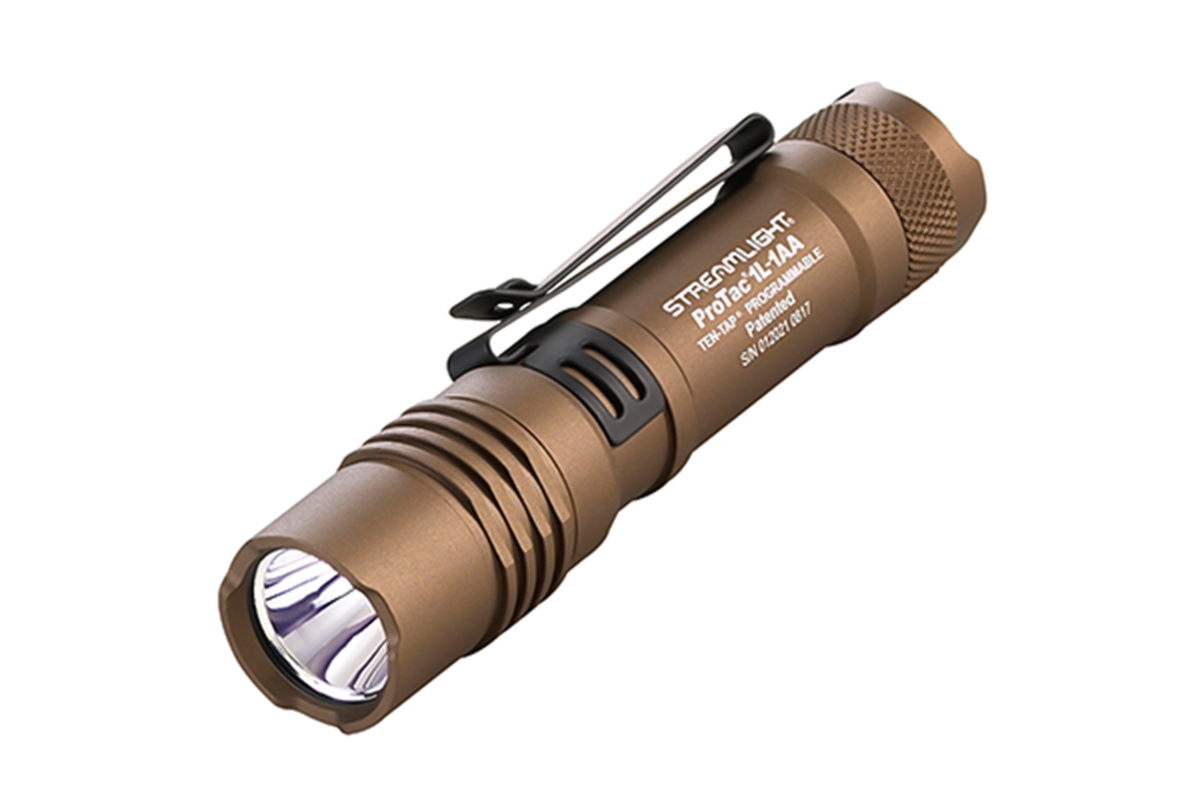
If you ask a gear tester what their favorite EDC item is, there’s a good chance they’ll pick a flashlight over their knife. The Streamlight ProTac 1L-1AA is one of my personal favorites, and it makes a great flashlight in addition to being a reliable everyday piece of gear.
Unlike most flashlights on this list, this one doesn’t use a rechargeable battery (although the ProTac HL is available with a rechargeable lithium-ion battery). Instead, you can run this little flashlight with an alkaline AA battery, a lithium AA battery, or a CR123 battery.
A lithium AA battery will be your best power source across all lighting modes, with a lifespan of 4.25 hours on high (350 lumens), 14 hours on low (40 lumens), or eight hours on strobe mode.
The ProTac 1L-1AA stands out when it comes to surviving hard use. The aluminum body and IPX7 waterproof rating mean you can count on it, no matter where life takes you.
The two-way pocket clip helps secure it in your pocket or mount it on your hat brim like a headlamp. If you want a handheld flashlight and don’t care about having a red light mode, throw one of these in your pocket and call it a day.
Why we love it: This EDC flashlight is barely larger than a tube of chapstick and it can use AA or CR123 batteries.
Things we’d change: If you prefer a rechargeable flashlight, opt for the Streamlight ProTac HL.
Best for the Tent – Black Diamond Moji R+ Lantern
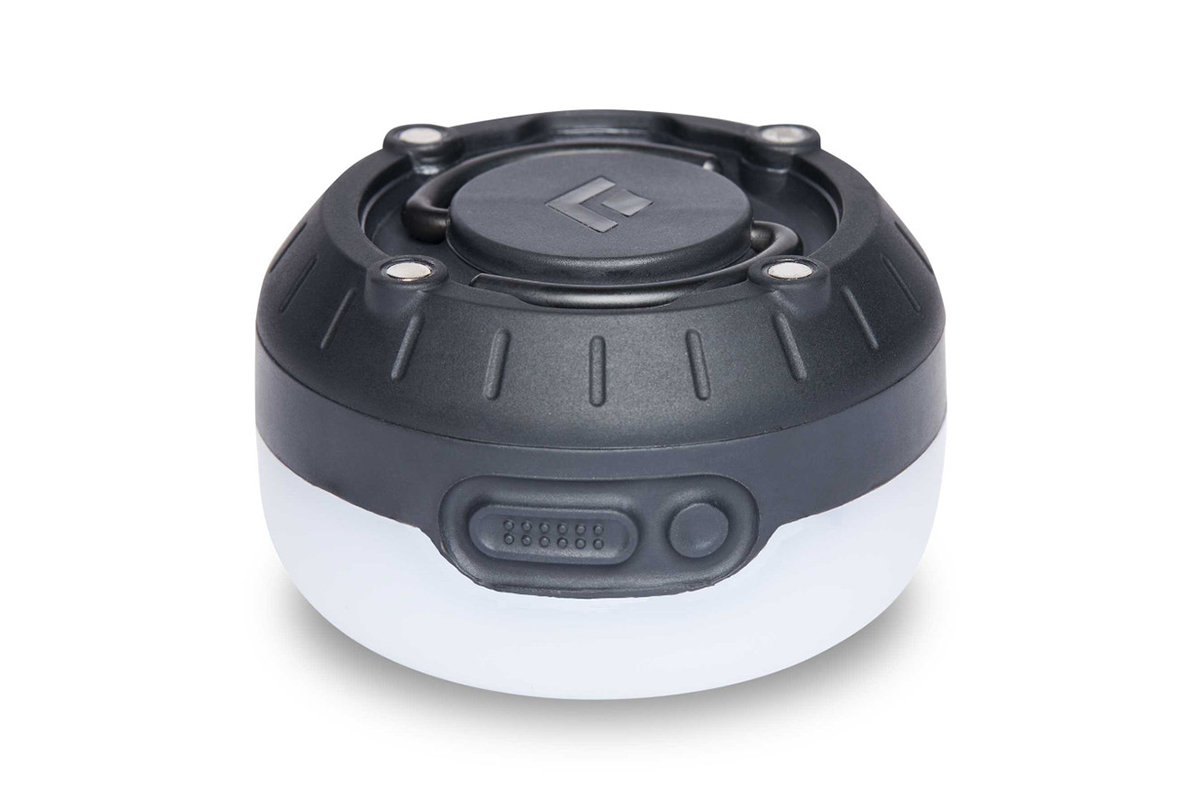
If you’ve ever tried to use a flashlight for ambient light, you know that’s a losing battle. What you need is a camping lantern. The Black Diamond Moji R+ Lantern fits in the palm of your hand but puts off enough light to make your campsite or tent feel like home.
The frosted exterior of the Moji R+ produces 200 lumens of soft light that’s easy on the eyes, and you can set it to cycle through the color spectrum or set it to any color you like.
Power modes include low, medium, and high, with up to 200 hours of battery life from the rechargeable internal battery.
Two retractable hooks make it easy to hang this lantern from a branch or piece of paracord for overhead light, and the IPX4 water resistance rating makes it safe for outdoor use.
Camping lanterns can be hard to justify for backpackers who have limited space, but the Moji R+ is small enough to carry anywhere. After one night with it, you’ll probably wonder why you ever camped without one.
Why we love it: The soft glow from this compact lantern is great inside a tent.
Things we’d change: Some lanterns can be used as a portable power bank, but not this one.
Best Pocket Sized – Fenix E03R v 2.0 Keychain Flashlight
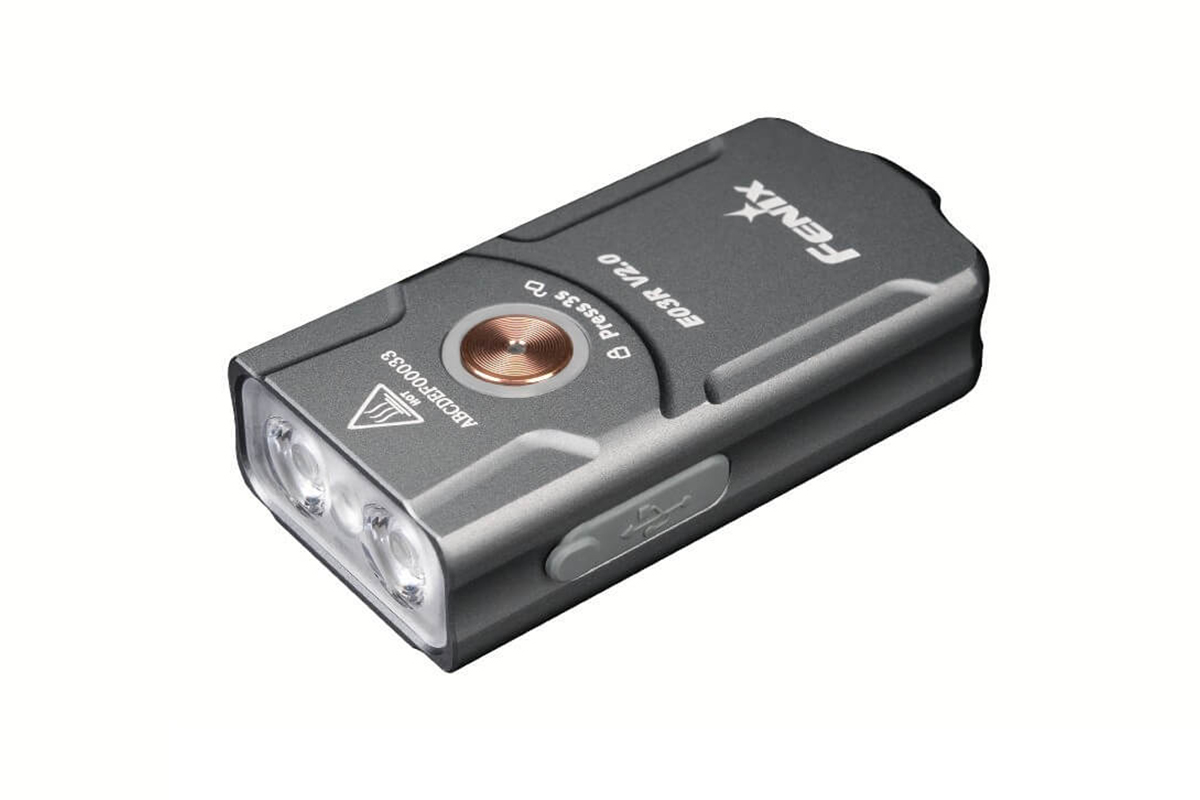
Sometimes you don’t need a bunch of features, you just need light—right now. The Fenix E03R v 2.0 Keychain Flashlight is perfect for clipping to your keychain or the shoulder strap of your pack so you’re always ready.
While this rechargeable flashlight shouldn’t be the primary light you rely on, it’s useful for finding things in your pack or navigating dark trailheads.
Power modes include high (500 lumens for one hour and 20 minutes), medium (150 lumens for two hours), and low (30 lumens for six hours and 35 minutes).
There are also five-lumen red modes for steady and flashing light, and a one-lumen “breathing light” that helps you find the power button in the dark.
This little powerhouse is impact-resistant and rated for water and dust protection at IP66. At about $30, it’s a great way to stay ready without digging out your primary portable flashlight.
Why we love it: Clip this flashlight to your pack or car keys so you’re always prepared.
Things we’d change: This is a handy flashlight, just make sure it’s not your only one.
Most Durable – Streamlight Sidewinder Compact II
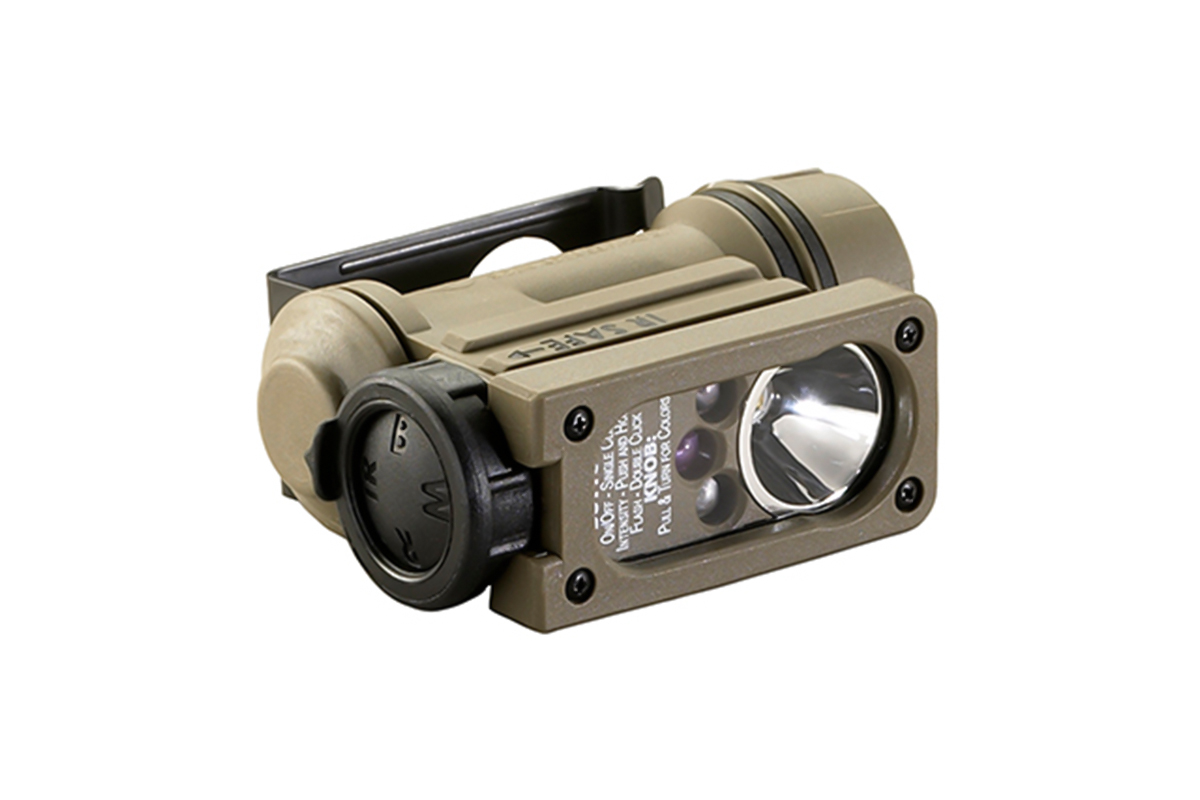
The Streamlight Sidewinder Compact II traces its roots to the world of military contracts, and it has a proven track record that makes it a fantastic choice for campers and backpackers who demand tough equipment.
You can clip this little flashlight to a headband or a shoulder strap for hands-free light or use it on its own like a tiny handheld flashlight. Light modes include white, red, blue, and even infrared (for all of you who camp with night vision goggles).
All four have four power settings and a strobe function. Power comes from either a CR123 or AA battery (lithium or alkaline), with a maximum battery life of more than 100 hours on the lowest setting.
The IR light setting is overkill for camping, but the MIL-STD-810F durability rating is something every camper can appreciate and few flashlights can beat. When it comes to toughness and versatility, there’s a reason this tiny flashlight stuck around for decades of military use.
Why we love it: This flashlight is super tough, and you can clip it to a headband or shoulder strap to go hands-free.
Things we’d change: The price covers some military-focused features that most of us will never use.
What to Look for in a Camping Flashlight
We’ve all grabbed last-minute camping gear on the way out of town, but it’s obviously something we try to avoid. Finding a good flashlight isn’t something you should put off until you’re reliant on what the gas station has at the checkout counter. Here are some things to consider before you make your decision.
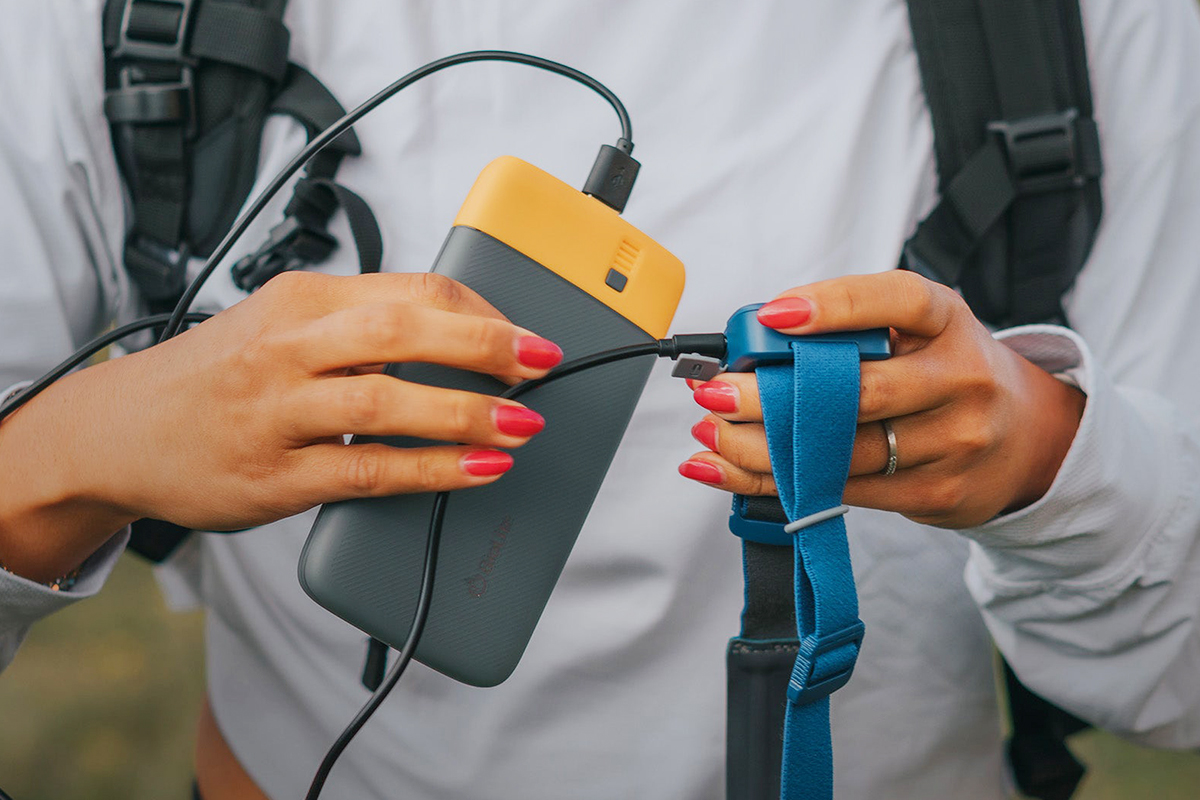
Types of Camping Flashlights
Generally, there are three kinds of flashlights people use for camping: handheld flashlights, headlamps, and lanterns. All three have their own advantages and shortcomings.
Handheld flashlights are versatile and many are small enough for you to carry every day.
Headlamps free up your hands to set up camp, cook a meal, or read in your tent after dark.
Camping lanterns create a cozy campsite without the harsh glare of a direct beam.
Features You Should Look For
Power
Once you’ve decided which style of flashlight you want, you can start to prioritize other features.
Power is a major factor for a lot of people and 1,000 lumens seems to be a popular benchmark. That’s way more than you’ll need in most camping situations, though, so it’s fine to look at flashlights with much lower output. Many flashlights have multiple brightness levels to choose from.
For setting up camp, cooking, and reading in your tent, 250 lumens or less is sufficient light. You probably don’t want much more when your eyes need to rapidly adjust to the dark around you.
On the other hand, you’ll need extra power as you start moving around. Running will require more power than hiking, and mountain biking after dark basically requires a head-mounted searchlight.
Rechargeable Flashlights
There are some great camp lights that still use disposable alkaline batteries, but most campers prefer the convenience and reduced environmental impact of rechargeable lithium-ion batteries over carrying spare batteries and wondering if they’re still charged.
Rechargeable batteries often come with LED indicators to give an idea of how long battery life will last.
If you do opt for a rechargeable flashlight, pay attention the the charging port. The electronic devices we take camping use all kinds of charging cables and you don’t want to be stuck in the dark with a USB-C port and a micro-USB cable.
Finally, take into account the combined power demands of your flashlight, phone, GPS device, and any other electronics you plan on packing when you’re looking at external power banks. Since you’re going to be camping, you’ll also want to buy one that’s relatively rugged. GoalZero and BioLite make some great options.
Waterproof Rating and Durability
Since you’re going to be using your flashlight outdoors, it’s important to be prepared for wet weather.
A flashlight’s IPX rating will give you an idea of how well it keeps water and dust outside, where it belongs. You should avoid cheap flashlights that can’t handle being dropped every now and then.
You certainly won’t want a fragile flashlight. Aluminum and high-strength polymers are great materials to look for. Old-school metal flashlights look tough but they’re heavy, and softer materials like a rubberized exterior actually absorb impacts better than bare metal.
Color Modes and Strobe Settings
White light is what our eyes prefer, but there are times when you might want something other than a steady beam of typical white light. Red, green, or blue light will preserve your night vision and help you get back to sleep after those midnight trips to nature’s bathroom.
Multiple brightness modes will help you get more use out of your flashlight because it can help you navigate on the trail and then provide a soft reading light when you go to bed.
Just familiarize yourself with your flashlight’s settings ahead of time, because they’re often controlled with a single button and frantically clicking through a series of flashing mystery settings gets old in a hurry.
One feature that often gets overlooked is a strobe function. Activating a strobe mode draws attention to let motorists and cyclists know that you’re on the trail, too, and can provide a powerful distress signal.
Some flashlights, like the BioLite HeadLamp 425, have a rear-facing red strobe light that’s great for runners and cyclists.
Brands We Trust
There are a lot of companies making great gear these days, but some of our favorite manufacturers of the best camping flashlights include BioLite, Black Diamond, Fenix, and Streamlight. If you end up looking for flashlights that aren’t on this list, these brands are a great place to shop.
Camping Flashlight Q&A

How much do the best camping flashlights cost?
You can get some of the best flashlights for a very reasonable price. Our picks cost anywhere from $30 for budget lights to $75 for a more expensive flashlight.
Price isn’t everything, though. Prioritize the features you need rather than associating a flashlight’s cost with its quality.
What kind of batteries do camping flashlights use?
Flashlights with rechargeable batteries are becoming increasingly common because they’re incredibly convenient. Most campers would rather plug their flashlight into a power bank alongside their phone or GPS watch than lug around a bunch of spare disposable batteries.
If you do opt for disposable batteries, most flashlights use CR123, AA, or AAA batteries.
Some flashlights, like the Streamlight ProTac 1L-1AA and Streamlight Sidewinder Compact II can use multiple kinds of batteries. Performance may vary; for example, some flashlights produce more power on the highest setting with certain types of batteries.
How many lumens should a camping flashlight produce?
While you certainly don’t want an underpowered camping flashlight, there is such a thing as too much power.
There’s probably no need to have more than 1,000 lumens. You might want 500 to 750 lumens if you’re hiking at night, and having the option to use 250 lumens or less can be nice when you want to find something in your tent without blinding yourself for the next several minutes.
Most flashlights offer multiple power settings. The lowest, sometimes called eco mode, will be useful in your tent when a subtle glow will do the trick. High-output modes are better for hiking or running after dark when you need to navigate and spot trip hazards in front of you.
Naturally, brighter power settings will drain conventional or rechargeable batteries faster.









